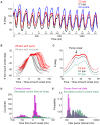Fast feedback in active sensing: touch-induced changes to whisker-object interaction
- PMID: 23028512
- PMCID: PMC3445569
- DOI: 10.1371/journal.pone.0044272
Fast feedback in active sensing: touch-induced changes to whisker-object interaction
Abstract
Whisking mediated touch is an active sense whereby whisker movements are modulated by sensory input and behavioral context. Here we studied the effects of touching an object on whisking in head-fixed rats. Simultaneous movements of whiskers C1, C2, and D1 were tracked bilaterally and their movements compared. During free-air whisking, whisker protractions were typically characterized by a single acceleration-deceleration event, whisking amplitude and velocity were correlated, and whisk duration correlated with neither amplitude nor velocity. Upon contact with an object, a second acceleration-deceleration event occurred in about 25% of whisk cycles, involving both contacting (C2) and non-contacting (C1, D1) whiskers ipsilateral to the object. In these cases, the rostral whisker (C2) remained in contact with the object throughout the double-peak phase, which effectively prolonged the duration of C2 contact. These "touch-induced pumps" (TIPs) were detected, on average, 17.9 ms after contact. On a slower time scale, starting at the cycle following first touch, contralateral amplitude increased while ipsilateral amplitude decreased. Our results demonstrate that sensory-induced motor modulations occur at various timescales, and directly affect object palpation.
Conflict of interest statement
Figures







Similar articles
-
Temporal organization of multi-whisker contact in rats.Somatosens Mot Res. 2001;18(2):91-100. doi: 10.1080/135578501012006192. Somatosens Mot Res. 2001. PMID: 11534778
-
Sensorimotor integration in the whisker somatosensory brain stem trigeminal loop.J Neurophysiol. 2019 Nov 1;122(5):2061-2075. doi: 10.1152/jn.00116.2019. Epub 2019 Sep 18. J Neurophysiol. 2019. PMID: 31533013
-
Mechanisms of tactile information transmission through whisker vibrations.J Neurosci. 2009 Sep 16;29(37):11686-97. doi: 10.1523/JNEUROSCI.0705-09.2009. J Neurosci. 2009. PMID: 19759315 Free PMC article.
-
Whisking mechanics and active sensing.Curr Opin Neurobiol. 2016 Oct;40:178-188. doi: 10.1016/j.conb.2016.08.001. Epub 2016 Sep 13. Curr Opin Neurobiol. 2016. PMID: 27632212 Free PMC article. Review.
-
Anatomical loops and their electrical dynamics in relation to whisking by rat.Somatosens Mot Res. 1999;16(2):69-88. doi: 10.1080/08990229970528. Somatosens Mot Res. 1999. PMID: 10449057 Review.
Cited by
-
Mediation of muscular control of rhinarial motility in rats by the nasal cartilaginous skeleton.Anat Rec (Hoboken). 2013 Dec;296(12):1821-32. doi: 10.1002/ar.22822. Epub 2013 Oct 29. Anat Rec (Hoboken). 2013. PMID: 24249396 Free PMC article.
-
Decoupling kinematics and mechanics reveals coding properties of trigeminal ganglion neurons in the rat vibrissal system.Elife. 2016 Jun 27;5:e13969. doi: 10.7554/eLife.13969. Elife. 2016. PMID: 27348221 Free PMC article.
-
Beyond cones: an improved model of whisker bending based on measured mechanics and tapering.J Neurophysiol. 2016 Aug 1;116(2):812-24. doi: 10.1152/jn.00511.2015. Epub 2016 Jun 1. J Neurophysiol. 2016. PMID: 27250911 Free PMC article.
-
Theory of hierarchically organized neuronal oscillator dynamics that mediate rodent rhythmic whisking.Neuron. 2022 Nov 16;110(22):3833-3851.e22. doi: 10.1016/j.neuron.2022.08.020. Epub 2022 Sep 15. Neuron. 2022. PMID: 36113472 Free PMC article.
-
Gradient of tactile properties in the rat whisker pad.PLoS Biol. 2020 Oct 22;18(10):e3000699. doi: 10.1371/journal.pbio.3000699. eCollection 2020 Oct. PLoS Biol. 2020. PMID: 33090990 Free PMC article.
References
-
- Diamond ME, von Heimendahl M, Knutsen PM, Kleinfeld D, Ahissar E (2008) ‘Where’ and ‘what’ in the whisker sensorimotor system. Nature Reviews Neuroscience 9: 601–612. - PubMed
-
- Jenkinson EW, Glickstein M (2000) Whiskers, barrels, and cortical efferent pathways in gap crossing by rats. Journal of Neurophysiology 84: 1781–1789. - PubMed
Publication types
MeSH terms
LinkOut - more resources
Full Text Sources
Miscellaneous

